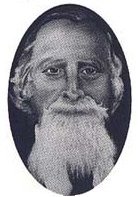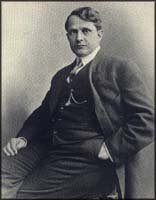SAINT JOHN'S CHURCH
(CHAPEL BACH)
STATION ROAD, TIRYDAIL
(Denomination: Church in Wales)
and The Moose Hall
Ammanford's Welsh Wesleyans, by agreement with local preacher and educationalist Watcyn Wyn, originally conducted their services in his little schoolroom in Brynmawr Lane (now the English Baptist Church). Like all organisations which start small but have grand ambitions, they aspired to a home of their own. So, in 1906, they purchased a small Chapel (built in 1892 by the Christadelphians), located at the junction of Harold Street and Station Road. With a growing congregation these premises soon proved inadequate and in October 1911 the Welsh Wesleyans built their own substantial Chapel on Tirydail Square.
In 1911 Ammanford, which until then had belonged for ecclesiastical purposes to the Parish of Llandybie, merged with the much nearer Parish of Betws to create the new Parish of Betws-cum-Ammanford. Due to the explosive growth of the Amman Valley's population the church, in common with the much more numerous non-conformist worshippers, faced acute problems of accommodation for its members. At this time Ammanford's only church was St Michaels's on Wind Street, which had been built as recently as 1885. Even when a Church Hall was added across the road in 1900 there was still a shortage of places for church-goers to worship. Long term the solution would only be solved when the church of All Saints, with seating for 500, was built on Brynmawr Hill in 1915. But in 1911 the Vicar of Ammanford - the Reverend John Wilton Jones B.A. - took the step of entering into a leasehold agreement with the Wesleyan Methodist Trust to establish a Mission for their Tirydail members in the Wesleyan's old chapel on Station Road, which they named Saint John's Church.
Known by Tirydail folk as Chapel Bach (Little Chapel) St John's was used as a church and Sunday school for Tirydail's Anglican worshippers throughout the inter-war years and into the post-war period. But when potential worshippers were presented with alternative uses for their leisure time in the form of the newly introduced television service and the increasingly affordable car, support for the Mission dwindled, prompting the Parochial Council to finally accept that it was no longer a viable proposition to maintain the building as a church. Its windows were boarded up and Saint John's was closed in 1974.
"The Family Fraternity: an organisation of 1.5 million men and women in four nations dedicated to bettering the lives of children and the elderly in need, to helping make our local and international communities better places in which to live and raise families, and to providing wholesome family recreation at modest cost." The Moose aims and objectives. The Loyal Order of Moose
In anticipation of difficulties in disposing of the premises the ground landlord was approached to release the freehold interest of the property. At a private auction the property was sold in 1982 for £6,500 to the Ammanford Lodge of the Loyal Order Of Moose, or as it is now known today, Moose International.
This is an odd sounding name for a Welsh organisation. Moose (or should that be meese?) haven't been seen in Britain since the last ice age ended about 10,000 years ago. With the retreating ice sheets went all Arctic animals such as moose, reindeer, woolly mammoths, and many others, some even into extinction. This should give us a clue that the Loyal Order of Moose originated not in Wales at all but in North America. Back in 1888 a Dr Wilson of Scottish descent had studied the habits of this strange looking creature, the largest member of the deer family. He became fascinated by the way the animal protected its young and old and it inspired him, if that is the word, to form a society for the promotion of humanitarianism and philanthropy by helping those in society less fortunate than others. Patriotism and religious tolerance were added to the aims of the organisation, though scientists who've studied the behavioural patterns of the moose since the good Dr Wilson have failed to discern these qualities in this otherwise worthy animal.
The aims and objectives of the International Moose are laid out in their website:
"The Family Fraternity: an organisation of 1.5 million men and women in four nations dedicated to bettering the lives of children and the elderly in need, to helping make our local and international communities better places in which to live and raise families, and to providing wholesome family recreation at modest cost."
Initially the new venture was not all that successful; but then the society was given new life and purpose through the energy and foresight of a Welshman, James J. Davies, who established a flourishing network of Moose Lodges in America. On his return to his birthplace of Tredegar in 1926 he set up the first of the British Lodges. Here is a brief history of Moose International extracted from their website:
John Henry Wilson, founder of the Loyal Order of Moose in the USA. Though the Moose fraternal organisation was founded in the late 1800s with the modest goal of offering men an opportunity to gather socially, it was reinvented during the first decade of the 20th century into an organizational dynamo of men and women who set out to build a city that would brighten the futures of thousands of children in need all across North America.
....When Dr. John Henry Wilson, a Louisville, Kentucky, physician, organized a handful of men into the Loyal Order of Moose in the parlour of his home in the spring of 1888, he and his compatriots did so apparently for no other reason than to form a string of men's social clubs. Lodges were instituted in Cincinnati, St. Louis, and the smaller Indiana towns of Crawfordsville and Frankfort by the early 1890s, but Dr. Wilson himself became dissatisfied and left the infant order well before the turn of the century.
....It was just two remaining Indiana Lodges that kept the Moose from disappearing altogether, until the fall of 1906, when an outgoing young government clerk from Elwood, Indiana, was invited to enrol into the Crawfordsville Lodge. It was on James J. Davis' 33rd birthday, October 27, that he became just the 247th member of the Loyal Order of Moose.
Tredegar-born James J. Davis, who built the Moose into an international organisation in the twentieth century. Davis, a native of Wales who had worked from boyhood as an iron puddler in the steel mills of Pennsylvania, had also been a labour organizer and immediately saw potential to build the tiny Moose fraternity into a force to provide protection and security for a largely working-class membership. At the time little or no government safety net existed to provide benefits to the wife and children of a breadwinner who died or became disabled. Davis proposed to "pitch" Moose membership as a way to provide such protection at a bargain price; annual dues of $5 to $10. Given a green light and the title of Supreme Organizer, Davis and a few other colleagues set out to solicit members and organize Moose Lodges across the U.S. and southern Canada. (In 1926, the Moose fraternity's presence extended across the Atlantic, with the founding of the Grand Lodge of Great Britain.)
....Davis' marketing instincts were on-target: By 1912, the order had grown from 247 members in two Lodges, to a colossus of nearly 500,000 in more than 1,000 Lodges. Davis, appointed the organization's first chief executive with the new title of Director General, realized it was time to make good on the promise. The Moose began a program of paying sick benefits to members too ill to work and, more ambitiously, Davis and the organization's other officers made plans for a Moose Institute, to be centrally located somewhere in the Midwest that would provide a home, schooling and vocational training to children of deceased Moose members.Meanwhile, across the pond in Ammanford, at a legally constituted meeting held at the Drill Hall, Ammanford, on the 12th of January 1928, sixty-eight founder members appended their signatures to an application to form the Ammanford Lodge No 30 and were granted a charter on the 1st of June 1928.
Amongst those prominent business and professional men who signed the form were:
D. L. Thomas Auctioneer O. D. Edwards Proprietor - Cross Inn Hote D. Ewart Davies Dental Surgeon Fred Trevett Journalist J. M. Darbyshire Coal Merchant W. Eustace Llewelyn Solicitor J. P Fletcher Boot & Shoe Maker R. Kaltenbach Jeweller L. C. Lynn Lewis Medical Practitioner J. Percy James Omnibus Proprietor J. D. Edwards Butcher Ben Jones Cabinet Maker R. Oehler Jeweller D. R. Davies Bank Manager Thomas Lancett Painter & Decorator David Mainwaring Printers Leslie Harries Ironmonger Willie Rees Tailor The Lodge held their meetings in the vestry of the English Wesleyan Church in Wind Street, though sometimes accommodation was not available and alternative rooms had to be found. Clearly an assembly room of their own was needed and this was achieved by the purchase of the old Saint John's Church in 1982. With enthusiasm the members soon carried out various modifications to convert the building into a meeting place and community centre. St John's Church and Chapel Bach were no more and the renamed Moose Hall was born.
From its inception in Ammanford in 1928 the Moose raised significant amounts of money for local causes. But the usual problem faced by mutual organisations in our less public-spirited age eventually reared it ugly head – declining membership – and Ammanford Moose is no more, their role taken over in Ammanford by more recent fund-raising bodies such as the Rotary Club and the Lions.
The little building, which has been a church for Ammanford's Christadelphians, Wesleyans and Anglicans, and a meeting place for the Loyal Order of Moose, is currently the home of the Hafan Gobaith Day Centre (Haven of Hope Day Centre). This centre, run by the Amman Valley Dementia Carers' Support Group, is funded by various public bodies such as the Community Fund of the National Lottery, Carmarthenshire County Council and Awards for Wales. Its purpose is to provide facilities for sufferers of dementia and their carers, services which include aromatherapy massage, a luncheon club, social evenings, weekends away, and providing training information and counselling. At least the old building still provides a public service for the local community.
Sources: — Ammanford: Origin of street names and notable historic records; WTH Locksmith, 2001. — Moose International website.



